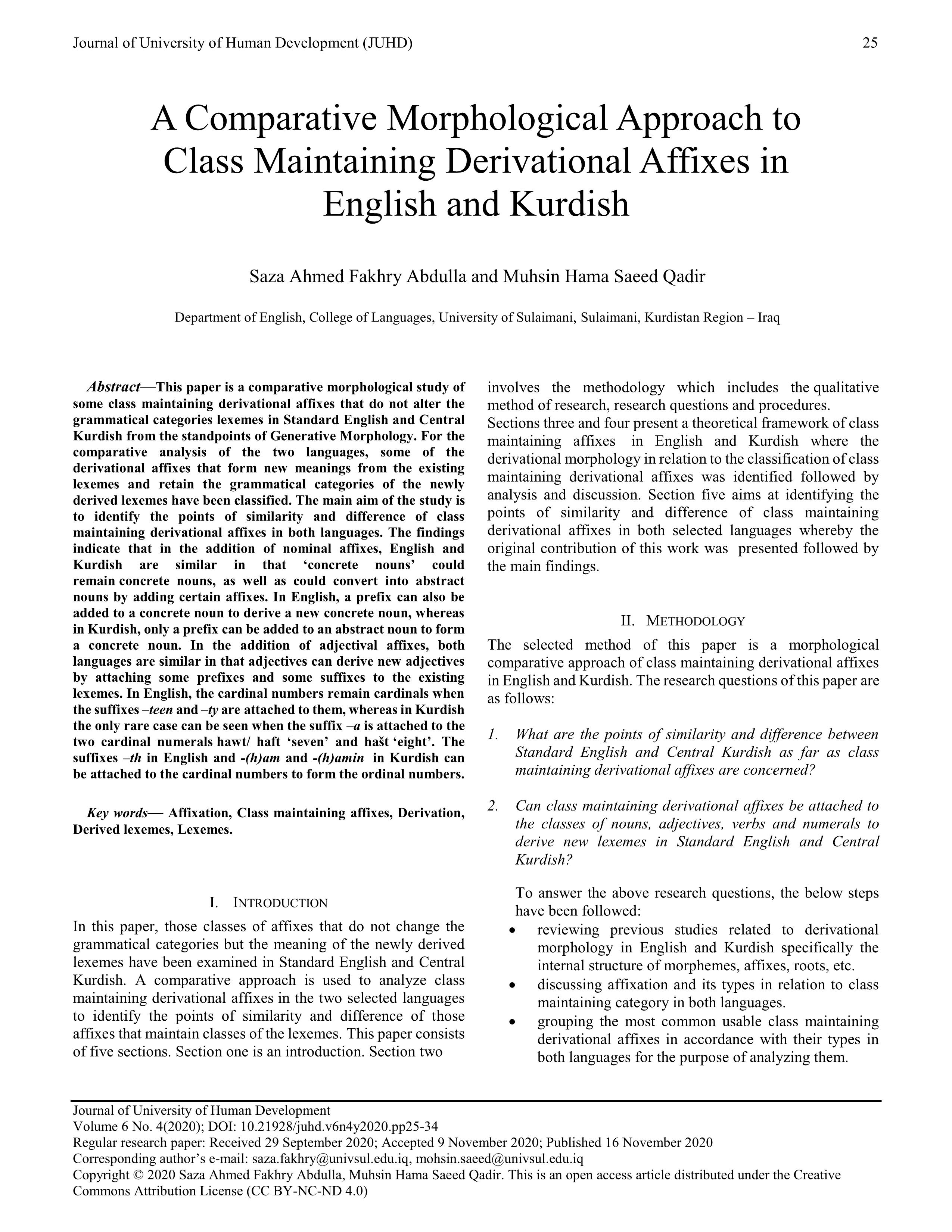A Comparative Morphological Approach to Class Maintaining Derivational Affixes in English and Kurdish
DOI:
https://doi.org/10.21928/juhd.v6n4y2020.pp25-34Keywords:
Affixation, Class maintaining affixes, Derivation, Derived lexemes, LexemesAbstract
This paper is a comparative morphological study of some class maintaining derivational affixes that do not alter the grammatical categories lexemes in Standard English and Central Kurdish from the standpoints of Generative Morphology. For the comparative analysis of the two languages, some of the derivational affixes that form new meanings from the existing lexemes and retain the grammatical categories of the newly derived lexemes have been classified. The main aim of the study is to identify the points of similarity and difference of class maintaining derivational affixes in both languages. The findings indicate that in the addition of nominal affixes, English and Kurdish are similar in that ‘concrete nouns’ could remain concrete nouns, as well as could convert into abstract nouns by adding certain affixes. In English, a prefix can also be added to a concrete noun to derive a new concrete noun, whereas in Kurdish, only a prefix can be added to an abstract noun to form a concrete noun. In the addition of adjectival affixes, both languages are similar in that adjectives can derive new adjectives by attaching some prefixes and some suffixes to the existing lexemes. In English, the cardinal numbers remain cardinals when the suffixes –teen and –ty are attached to them, whereas in Kurdish the only rare case can be seen when the suffix –a is attached to the two cardinal numerals hawt/ haft ‘seven’ and hašt ‘eight’. The suffixes –th in English and -(h)am and -(h)amin in Kurdish can be attached to the cardinal numbers to form the ordinal numbers.
References
Amin, W. O. (1982). Wuša {Words}. Nusari Kurd, No. 9.
Awl, M. O. (2010) Dabešbûnî Kirdarî Lêkdiraw Le Ŕwî Daŕištinw Erkewe {Classification of Compounding Verbs from the Compositional and Functional Perspectives}. Journal of Kurdology. Sulaimani.
Bauer, L. (1983). English Word-Formation. Cambridge, UK, Cambridge University Press.
Boskany, S. (2014). A Contrastive Analysis of Agreement in Standard English and Standard Kurdish. Haji Hashim Printing House – Erbil.
Clark, V., Hecht, B., & Mulford, R. (1986). Acquiring Complex Compounds, Affixes and Word Order in English. Linguistics p. 24, pp. 7-29.
Dizayee, A. M. (2012). Wišasazî Zimanî Kurdî [Kurdish Morphology]. Hewler, University of Salahaddin.
Dupanović, E. (2019). Class-Changing Prefixes in the English Language. DHS 2 (8) (2019), 73-88.
Fakhry, S. (2005). The Syntax of Numerals in Standard English And Standard Kurdish. Journal of Zankoy Sulaimani (ISSN). Part B, Issue 16, December 2005, pp. 197-212.
Fatah, A., Hamawand, Z. (2014). A Prototype Approach to Kurdish Prefixes. International Journal on Studies in English Language and Literature (IJSELL) Volume 2, Issue10, October 2014, PP 37-49 ISSN 2347-3126 (Print) & ISSN 2347-3134 (Online).
Fattah, A. H. (2012). A Cognitive Grammar Analysis of Suffixes in English and Kurdish. University of Sulaimani, published PhD dissertation.
Hamawandy, A. (2012). Derivational Morphemes in English with Reference to Dialects in Kurdish, A Comparative Analysis. Kirkuk University Journal- Humanity Studies Vol. 7 No, 3.
Hornby, A., Turnbull, J., Ashby, M., Lea, D., Parkinson, D., Phillips, P., Francis, B., Webb, S. & Bull, V., (2015). Oxford Advanced Learner's Dictionary of Current English. (9th ed.). Oxford, Oxford University Press.
Katamba, F. (1993). Morphology. London, The Macmillan Press.
Leningrad, A. (1986). Lexicology of the modern English language. 3rd ed. Moscow Higher School. BBK 81.2 Eng-923 A 84
McCarus, E. N. (1958). A Kurdish Grammar, Descriptive Analysis of the Kurdish of Sulaimaniya, Iraq. Washington, Washington Paladograph Company.
Muhammad, M. (2011). Zarawasazî Pêwana [Measure Terminology]. (2nd ed.) Hewler, Aras Publishing House.
Marif, A. (1998). Ŕêzmanî Kurdî /Bergî Yekem / Morfolojî / Bešî Çwarem / Jmare w Aweĺkrdar (Kurdish Grammar/Volume One/ Morphology/ Part Four/Number and Adverb). Baghdad, Kurdish academic press.
Marif, A. (2014). Ŕêzmanî Kurdî / Bergî Yekem / Morfolojî / Bešî Yekem / Naw (Kurdish Grammar/Volume One/ Morphology/ Part One/Noun). Hewler, Ŕojhalat Press and Publisher.
Marif, A. (2000). Ŕêzmanî Kurdî / Bergî Yekem / Morfolojî / Bešî Penjem / Krdar (Kurdish Grammar/ Volume One/ Morphology/ Part Five/ Verb). Sulaimani, Sardam Printing and Publishing House.
Qazzaz, S. (2000) The Sharezoor Kurdish-English Dictionary. Erbil, Aras Press and Publisher.
Somathasan M. (2018), The Study of Affixes (prefixes and suffixes), An ESL and Innovative Approach IJAR, -pdfs. semanticscholar.org
Stageberg, Norman C. (1981). An Introductory English Grammar. (4th ed.). USA, University of Northern Iowa.
Shwani, R. (2011). Wišasazy Zimanî Kûrdî, Lêkolînawayakî Pŕaktîkya [Kurdish Word Formation, A Practical Study]. Hewler, Mukryan Publishing House.
Umera-Okeke, N. (2007). Exploring Affixation in English. African Research Review Vol. 1 (3) 2007, pp. 9-35.



